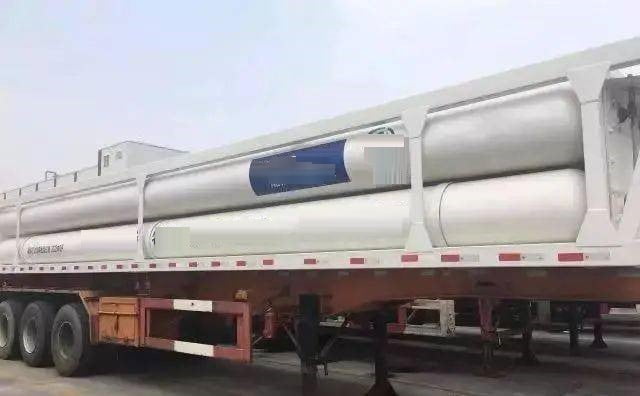Hydrogen transportation is an important part of hydrogen energy utilization. Generally speaking, there will be a certain distance between hydrogen production plants and users, which requires hydrogen transportation.
Based on the different state of hydrogen during transportation, it can be divided into gas hydrogen transportation, liquid hydrogen transportation and solid hydrogen transportation. The first two are currently being used on a large scale.
According to the transportation distance of hydrogen, the requirements of hydrogen use and the distribution of users, gas hydrogen can be transported by pipe network or high-pressure container mounted on vehicles, ships and other transportation vehicles. Pipe network transportation is generally suitable for occasions with large quantities, while vehicle and ship transportation is suitable for occasions with small quantities and scattered users. The transportation method of liquid hydrogen and solid hydrogen is generally by vehicle and ship.

Gaseous hydrogen transportation
The density of hydrogen is particularly small. In order to improve the delivery capacity, hydrogen is generally pressurized to greatly reduce the volume, and then installed in a high-pressure container, and transported over a longer distance by towing trucks or ships.
Technically, this transportation method is quite mature. The high-pressure tubular trailers commonly used in our country are generally equipped with 8 high-pressure gas storage pipes. Among them, the high-pressure gas storage pipe has a diameter of 0.6m, a length of 11m, a working pressure of 20MPa, and a working temperature of -40~60℃. The water volume of a single steel cylinder is 2.25m³ and the weight is 2730kg. Together with the accessories, the total weight of this vehicle is 26,030 kg, and it contains 285 kg of hydrogen. The efficiency of hydrogen delivery is only 1.1%. It can be seen that due to the heavy weight of conventional high-pressure hydrogen storage containers and the low density of hydrogen, the weight of hydrogen shipped only accounts for about 1 to 2% of the total transportation weight. It is only suitable for transporting hydrogen from a hydrogen plant to users who are not too far away and require a small amount of hydrogen at the same time.
According to the monthly hydrogen transportation of 252,000m³ and the distance of 130 kilometers, the current transportation cost of hydrogen is about 0.22 yuan/m³. For large and long-distance gas and hydrogen transportation, pipelines can be considered. The long-distance pipeline transportation of hydrogen has a history of more than 60 years.
The earliest long-distance hydrogen transmission pipeline was built in Ruhr, Germany in 1938. It has a total length of 208 kilometers. The diameter of the hydrogen transmission pipe is between 0.15 and 0.30 m. The rated hydrogen transmission pressure is about 2.5 MPa. It connects 18 production plants and users. , There has never been any accident.
There are approximately 1,500 kilometers of hydrogen pipelines in Europe. The longest hydrogen pipeline in the world is built between France and Belgium and is about 400 kilometers long. The currently used hydrogen pipelines are generally steel pipes with operating pressures of 1 to 2 MPa and diameters of 0.25 to 0.30 m. Transporting hydrogen through pipelines is the most effective long-distance transport method. What is worth mentioning is the problem of hydrogen loss during the transport process.
It is reported that the hydrogen loss rate during pipeline transportation is twice the energy loss rate during the same distance transmission process (about 7.5-8%). Ogden and others of Princeton University in the United States proposed that the cost of long-distance energy transmission through hydrogen pipelines is much lower than the cost of transmitting electricity through transmission lines.
Taking the United States as an example, let’s compare hydrogen pipelines and natural gas pipelines. Pipeline length The existing hydrogen pipeline in the United States is 720 kilometers, while the natural gas pipeline has 2.08 million kilometers, which is nearly 10,000 times the pipeline cost. The cost of the hydrogen pipeline in the United States is 310,000 to 940,000 kilometers, while the cost of the natural gas pipeline is only 125,000~ The cost of hydrogen pipelines is more than twice that of natural gas pipelines for 500,000 USD kilometers.
Gas transmission costs: Because of the amount of energy transported by gas in the pipeline, it depends on the volume and flow rate of the transported gas. The flow rate of hydrogen in the pipeline is about 2.8 times that of natural gas, but the energy density of the same volume of hydrogen is only 1/3 of that of natural gas.
Therefore, using the same pipeline to transport hydrogen and natural gas of the same energy, the power of the compressor for pumping hydrogen is much higher than that of the compressor for compressing natural gas, which results in a higher cost of hydrogen transportation than natural gas.
In fact, the existing natural gas pipeline can be used to transport a mixture of hydrogen and natural gas, or it can be modified to transport pure hydrogen. This depends mainly on the carbon content of the steel pipe material. Low-carbon steel is more suitable for transporting pure hydrogen.
The pressure of natural gas pipelines is relatively low (generally around 0.4MPa), and lower-priced plastic pipes such as polyvinyl chloride (PVC) and new high-density polyethylene pipes can be used. However, these plastic pipes cannot be used to transport hydrogen.
Many major cities in the world have built such pipelines. Initially they were built to transmit city gas to ordinary households. City gas contains about 50% hydrogen and 5% CO. The earliest city gas pipeline appeared in about 1800.